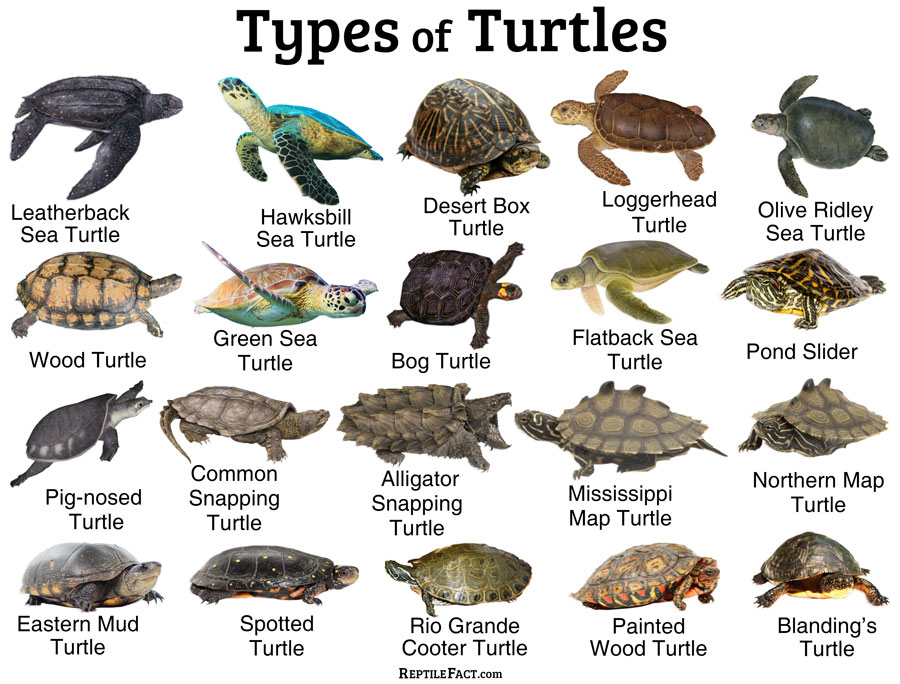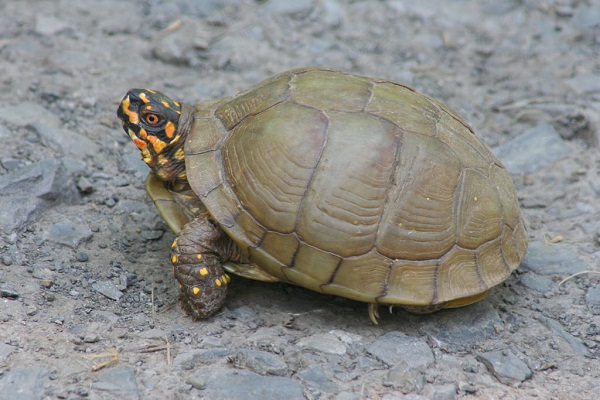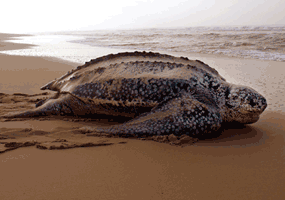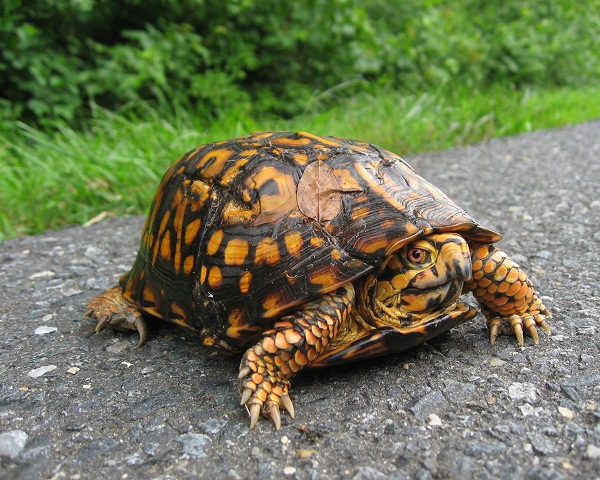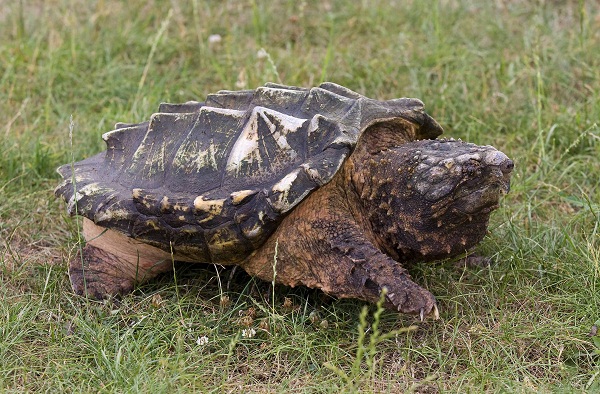Turtles
Turtles (Testudines) are one of the most prominent reptile orders, characterized by their large bony shells that act as their primary defense mechanism. The head and limbs are retrieved within the shell whenever they are threatened. Usually, it is believed that turtles and tortoises are two different groups, with all turtles living in water and all tortoises living on land. In truth, however, tortoises comprise the family Testudinidae in the Testudines order, while all animals in this order are counted as turtles.
The following list contains all the families, genera, and species in the turtle order, except those included in the Testudinidae, or true tortoise family.
1. Pignose Turtles (Carettochelyidae) |
||
| Pig-nosed turtle (Carettochelys insculpta) | ||
2. Softshell Turtles (Trionychidae) |
||
| Nubian flapshell (Cyclanorbis elegans) | Senegal flapshell (Cyclanorbis senegalensis) | Zambezi flapshell (Cycloderma frenatum) |
| Aubry’s flapshell (Cycloderma aubryi) | Indian flapshell (Lissemys punctata) | Burmese flapshell (Lissemys scutata) |
| Sri Lankan flapshell (Lissemys ceylonensis) | Asiatic softshell (Amyda cartilaginea) | Amyda ornata |
| Smooth softshell (Apalone mutica) | Florida softshell (Apalone ferox) | Spiny softshell (Apalone spinifera) |
| Indian narrow-headed softshell (Chitra indica) | Asian narrow-headed softshell (Chitra chitra) | Burmese narrow-headed softshell (Chitra vandijki) |
| Malayan softshell (Dogania subplana) | Ganges softshell (Nilssonia gangetica) |
Burmese peacock softshell (Nilssonia formosa) |
| Indian peacock softshell (Nilssonia hurum) | Black softshell (Nilssonia nigricans) | Leith’s softshell (Nilssonia leithii) |
| Wattle-necked softshell (Palea steindachneri) | New Guinea giant softshell (Pelochelys bibroni) | Northern New Guinea giant softshell (Pelochelys signifera) |
| Cantor’s giant softshell (Pelochelys cantorii) | Amur softshell (Pelodiscus maackii) | Hunan softshell (Pelodiscus axenaria) |
| Spotted softshell (Pelodiscus variegatus) | Chinese softshell (Pelodiscus sinensis) | Lesser Chinese softshell (Pelodiscus parviformis) |
| Yangtze giant softshell (Rafetus swinhoei) | Euphrates softshell (Rafetus euphraticus) | African softshell (Trionyx triunguis) |
3. Pond Turtles (Emydidae) |
||
| Spotted turtle (Clemmys guttata) | European pond turtle (Emys orbicularis) | Sicilian pond turtle (Emys trinacris) |
| Western pond turtle (Emys marmorata) | Blanding’s turtle (Emys blandingii) | Southwestern pond turtle (Emys pallida) |
| Wood turtle (Glyptemys insculpta) | Bog turtle (Glyptemys muhlenbergii) | Chicken turtle (Deirochelys reticularia) |
| Diamondback terrapin (Malaclemys terrapin) | ||
− Box Turtles (Terrapene) |
||
| Common box turtle (Terrapene carolina) ― Eastern box (T.c. carolina), Florida box (T.c. bauri), Gulf Coast box (T.c. major), Three-toed box (T.c. triunguis) | ||
| Spotted box turtle (Terrapene nelsoni) ― Southern spotted (T.n. nelsoni), Northern spotted (T.n. klauberi) | ||
| Western box turtle (Terrapene ornata) ― Ornate box (T.o. ornata), Desert box (T.o. luteola) | ||
| Coahuilan box turtle (Terrapene coahuila) | Yucatán box turtle (Terrapene yucatana) | Mexican box turtle (Terrapene mexicana) |
− Painted Turtle (Chrysemys) |
||
| Painted turtle (Chrysemys picta) ― Eastern painted (C. p. picta), Southern painted (C. p. dorsalis), Midland painted (C. p. marginata), Western painted (C. p. bellii) | ||
− Map Turtles (Graptemys) |
||
| False map turtle (Graptemys pseudogeographica) ― False map turtle (G. p. pseudogeographica), Mississippi map turtle (G. p. kohnii) | ||
| Cagle’s map turtle (Graptemys caglei) | Yellow-blotched map turtle (Graptemys flavimaculata) |
Barbour’s map turtle (Graptemys barbouri) |
| Northern map turtle (Graptemys geographica) | Escambia map turtle (Graptemys ernsti) | Pascagoula map turtle (Graptemys gibbonsi) |
| Black-knobbed map turtle (Graptemys nigrinoda) | Pearl River map turtle (Graptemys pearlensis) | Ringed map turtle (Graptemys oculifera) |
| Ouachita map turtle (Graptemys ouachitensis) | Alabama map turtle (Graptemys pulchra) | Sabine map turtle (Graptemys sabinensis) |
| Texas map turtle (Graptemys versa) | ||
− Slider Turtles (Trachemys) |
||
| Colombian slider (Trachemys callirostris) ― Colombian slider (T. c. callirostris), Venezuelan slider (T. c. chichiriviche) | ||
| Cuban slider (Trachemys decussata) ― Western Cuban slider (T. d. angusta), Eastern Cuban slider (T. d. decussata) | ||
| Big Bend slider (Trachemys gaigeae) ― Big Bend slider (T. g. gaigeae), Nazas slider (T. g. hartwegi) | ||
| Baja California slider (Trachemys nebulosa) ― Baja California slider (T. n. nebulosa), Fuerte slider (T. n. hiltoni) | ||
| Pond slider (Trachemys scripta) ― Red-eared slider (T. s. elegans), Yellow-bellied slider (T. s. scripta), Cumberland slider (T. s. troostii) | ||
| Central Antillean slider (Trachemys stejnegeri) ― Puerto Rican slider (T. s. stejnegeri), Inagua slider (T. s. malonei), Dominican slider (T. s. vicina) | ||
| Meso-American slider (Trachemys venusta) ― Gray’s slider (T. v. grayi), Huasecan slider (T. v. cataspila), Panamanian slider (T. v. panamensis), Yucatan slider (T. v. iversoni), Belize slider (T. v. venusta), Uhrig’s slider (T. v. uhrigi) | ||
| Hispaniolan slider (Trachemys decorata) | D’Orbigny’s slider (Trachemys dorbigni) | Atrato slider (Trachemys medemi) |
| Brazilian/Maranhão slider (Trachemys adiutrix) | Yaqui slider (Trachemys yaquia) | Ornate slider (Trachemys ornata) |
| Cuatro Ciénegas slider (Trachemys taylori) | Nicaraguan slider (Trachemys emolli) | Jamaican slider (Trachemys terrapen) |
− Cooters (Pseudemys) |
||
| River cooter (Pseudemys concinna) ― Eastern river cooter (P.c. concinna), Suwannee cooter (P.c. suwanniensis) | ||
| Alabama red-bellied cooter (Pseudemys alabamensis) | Florida red-bellied cooter (Pseudemys nelsoni) | Coastal plain cooter (Pseudemys floridana) |
| Rio Grande cooter (Pseudemys gorzugi) | Northern red-bellied cooter (Pseudemys rubriventris) | Peninsula cooter (Pseudemys peninsularis) |
| Texas river cooter (Pseudemys texana) | ||
4. Austro-South American Side-Neck Turtles (Chelidae) |
||
| Mary River turtle (Elusor macrurus) | Manning River snapping turtle (Flaviemys purvisi) | Saw-shelled turtle (Myuchelys latisternum) |
| Namoi River snapping turtle (Myuchelys bellii) | Bellinger River snapping turtle (Myuchelys georgesi) | Fitzroy River turtle (Rheodytes leukops) |
| Mata mata (Chelus fimbriata) | Brazilian radiolated swamp turtle (Acanthochelys radiolata) | Big-headed pantanal swamp turtle (Acanthochelys macrocephala) |
| Chaco side-necked turtle (Acanthochelys pallidipectoris) | Black spine-neck swamp turtle (Acanthochelys spixii) | Dahl’s toad-headed turtle (Mesoclemmys dahli) |
| Mesoclemmys hogei | Gibba turtle (Mesoclemmys gibba) | Mesoclemmys perplexa |
| Mesoclemmys nasuta | Amazon toad-headed turtle (Mesoclemmys raniceps) |
Vanderhaege’s toad-headed turtle (Mesoclemmys vanderhaegei) |
| Tuberculate toad-headed turtle (Mesoclemmys tuberculata) | Zulia toad-headed turtle (Mesoclemmys zuliae) |
Geoffroy’s toadhead turtle (Phrynops geoffroanus) |
| Cotinga River toadhead turtle (Phrynops tuberosus) | Hilaire’s toadhead turtle (Phrynops hilarii) | William’s toadhead turtle (Phrynops williamsi) |
| Twist-necked turtle (Platemys platycephala) | Red side-necked turtle (Rhinemys rufipes) | Brazilian snake-necked turtle (Hydromedusa maximiliani) |
| Argentine snake-necked turtle (Hydromedusa tectifera) | Western swamp turtle (Pseudemydura umbrina) | |
− Snake-Necked Turtles (Chelodina) |
||
| Eastern long neck turtle (Chelodina longicollis) | Cann’s snake-necked turtle (Chelodina canni) | Roti Island snake-necked turtle (Chelodina mccordi) |
| Gunalen’s snake-necked turtle (Chelodina gunaleni) | New Guinea snake-necked turtle (Chelodina novaeguineae) | Pritchard’s snakeneck turtle (Chelodina pritchardi) |
| Reimann’s snakeneck turtle (Chelodina reimanni) | Dinner-plate turtle (Chelodina steindachneri) | Giant snake-necked turtle (Chelodina expansa) |
| Arnhem Land long-necked turtle (Chelodina burrungandjii) | Kuchling’s snake-necked turtle (Chelodina kuchlingi) | North Australian snake-necked turtle (Chelodina rugosa) |
| Parker’s snake-necked turtle (Chelodina parkeri) |
Narrow-breasted snake-necked turtle (Chelodina colliei) | Kimberley snake-necked turtle (Chelodina walloyarrina) |
− Australian Snapping Turtles (Elseya) |
||
| Branderhorst’s snapping turtle (Elseya branderhorsti) | White-throated snapping turtle (Elseya albagula) | Yellow bellied snapping turtle (Elseya flaviventralis) |
| Irwin’s turtle (Elseya irwini) | Northern snapping turtle (Elseya dentata) | Gulf snapping turtle (Elseya lavarackorum) |
| Western New Guinea stream turtle (Elseya novaeguineae) | Northern New Guinea stream turtle (Elseya schultzei) | Southern New Guinea stream turtle (Elseya rhodini) |
− Australian Short-Necked Turtles (Emydura) |
||
| Macquarie turtle (Emydura macquarii) | Northern yellow-faced turtle (Emydura tanybaraga) | Red-bellied short-necked turtle (Emydura subglobosa) |
| Victoria river red-faced turtle (Emydura victoriae) | ||
5. Pelomedusidae |
||
| African helmeted turtle (Pelomedusa subrufa) | ||
6. Podocnemididae |
||
| Madagascan big-headed turtle (Erymnochelys madagascariensis) | Big-headed Amazon River turtle (Peltocephalus dumerilianus) | Arrau turtle (Podocnemis expansa) |
| Magdalena River turtle (Podocnemis lewyana) | Red-headed Amazon River turtle (Podocnemis erythrocephala) | Six-tubercled Amazon River turtle (Podocnemis sextuberculata) |
| Savanna side-necked turtle (Podocnemis vogli) | Yellow-spotted river turtle (Podocnemis unifilis) |
|
7. Snapping Turtles (Chelydridae) |
||
| South American snapping turtle (Chelydra acutirostris) | Common snapping turtle (Chelydra serpentina) | Central American snapping turtle (Chelydra rossignonii) |
| Suwannee snapping turtle (Macrochelys suwanniensis) | Alligator snapping turtle (Macrochelys temminckii) | |
8. River Turtles (Dermatemydidae) |
||
| Central American river turtle (Dermatemys mawii) | ||
9. Sea Turtles (Cheloniidae) |
||
| Kemp’s ridley sea turtle (Lepidochelys kempii) | Olive ridley sea turtle (Lepidochelys olivacea) | Loggerhead sea turtle (Caretta caretta) |
| Hawksbill sea turtle (Eretmochelys imbricata) | Green sea turtle (Chelonia mydas) | Flatback sea turtle (Natator depressus) |
10. Dermochelyidae |
||
| Leatherback sea turtle (Dermochelys coriacea) | ||
11. Geoemydidae |
||
| Southern river terrapin (Batagur affinis) | Northern river terrapin (Batagur baska) | Three-striped roofed turtle (Batagur dhongoka) |
| Painted terrapin (Batagur borneoensis) | Red-crowned roofed turtle (Batagur kachuga) | Burmese roofed turtle (Batagur trivittata) |
| Asian leaf turtle (Cyclemys dentata) | Eastern black-bridged leaf turtle (Cyclemys pulchristiata) | Western black-bridged leaf turtle (Cyclemys atripons) |
| Assam leaf turtle (Cyclemys gemeli) | Enigmatic leaf turtle (Cyclemys enigmatica) | Oldham’s leaf turtle (Cyclemys oldhamii) |
| Myanmar brown leaf turtle (Cyclemys fusca) | Black pond turtle (Geoclemys hamiltonii) | Black-breasted leaf turtle (Geoemyda spengleri) |
| Ryukyu black-breasted leaf turtle (Geoemyda japonica) | Brahminy river turtle (Hardella thurjii) | Arakan forest turtle (Heosemys depressa) |
| Spiny turtle (Heosemys spinosa) | Giant Asian pond turtle (Heosemys grandis) | Yellow-headed temple turtle (Heosemys annandalii) |
| Sulawesi forest turtle (Leucocephalon yuwonoi) | Malayan snail-eating turtle (Malayemys macrocephala) | Mekong snail-eating turtle (Malayemys subtrijuga) |
| Khorat snail-eating turtle (Malayemys khoratensis) | Japanese pond turtle (Mauremys japonica) | Vietnamese pond turtle (Mauremys annamensis) |
| Yellow pond turtle (Mauremys mutica) | Caspian turtle (Mauremys caspica) | Balkan pond turtle (Mauremys rivulata) |
| Chinese broad-headed pond turtle (Mauremys megalocephala) | Spanish pond turtle (Mauremys leprosa) | Red-necked pond turtle (Mauremys nigricans) |
| Chinese stripe-necked turtle (Mauremys sinensis) | Chinese pond turtle (Mauremys reevesii) | Indian black turtle (Melanochelys trijuga) |
| Indian eyed turtle (Morenia petersi) | Burmese eyed turtle (Morenia ocellata) | Tricarinate hill turtle (Melanochelys tricarinata) |
| Malayan flat-shelled turtle (Notochelys platynota) | Bornean giant turtle (Orlitia borneensis) | Assam roofed turtle (Pangshura sylhetensis) |
| Brown roofed turtle (Pangshura smithii) | Indian tent turtle (Pangshura tentoria) | Indian roofed turtle (Pangshura tecta) |
| Four-eyed turtle (Sacalia quadriocellata) | Beale’s eyed turtle (Sacalia bealei) | Philippine forest turtle (Siebenrockiella leytensis) |
| Black marsh turtle (Siebenrockiella crassicollis) | Cane turtle (Vijayachelys silvatica) | Brown wood turtle (Rhinoclemmys annulata) |
| Maracaibo wood turtle (Rhinoclemmys diademata) | Colombian wood turtle (Rhinoclemmys melanosterna) | Black river turtle (Rhinoclemmys funerea) |
| Large-nosed wood turtle (Rhinoclemmys nasuta) | Furrowed wood turtle (Rhinoclemmys areolata) | Painted wood turtle (Rhinoclemmys pulcherrima) |
| Mexican spotted wood turtle (Rhinoclemmys rubida) | Spot-legged wood turtle (Rhinoclemmys punctularia) | |
− Asian Box Turtles (Cuora) |
||
| Amboina box turtle (Cuora amboirnensis) ― Wallacean box turtle (C.a. amboinensis), West Indonesian box turtle (C.a. couro), Malayan box turtle (C.a. kamaroma), Burmese box turtle (C.a. lineata) | ||
| Vietnamese three-striped box turtle (Cuora cyclornata) | Yellow-headed box turtle (Cuora aurocapitata) | Chinese box turtle (Cuora flavomarginata) |
| Bourret’s box turtle (Cuora bourreti) | McCord’s box turtle (Cuora mccordi) | Indochinese box turtle (Cuora galbinifrons) |
| Keeled box turtle (Cuora mouhotii) | Southern Vietnamese box turtle (Cuora picturata) | Pan’s box turtle (Cuora pani) |
| Yunnan box turtle (Cuora yunnanensis) | Zhou’s box turtle (Cuora zhoui) | Golden coin turtle (Cuora trifasciata) |
12. Musk and Mud Turtles (Kinosternidae) |
||
− Mud Turtles (Kinosternon) |
||
| Rough-footed mud turtle (Kinosternon hirtipes) ― Valley of Mexico mud turtle (K.h. hirtipes), Lake Chapala mud turtle (K.h. chapalaense), Mexican plateau mud turtle (K.h. murrayi), San Juanico mud turtle (K.h. magdalense), Viesca mud turtle (K.h. megacephalum), Patzcuarco mud turtle (K.h. tarascense) | ||
| White-lipped mud turtle (Kinosternon leucostomum) ― Northern white-lipped mud turtle (K.l. leucostomum), Southern white-lipped mud turtle (K.l. postinguinale) | ||
| Scorpion mud turtle (Kinosternon scorpioides) ― Scorpion mud turtle (K.s. scorpioides), Central Chiapas mud turtle (K.s. abaxillare), White-throated mud turtle (K.s. albogulare), Red-cheeked mud turtle (K.s. cruentatum) | ||
| Sonora mud turtle (Kinosternon sonoriense) ― Sonora mud turtle (K.s. sonoriense), Sonoyta mud turtle (K.s. longifemorale) | ||
| Eastern mud turtle (Kinosternon subrubrum) ― Eastern mud turtle (K.s. subrubrum), Mississippi mud turtle (K.s. hippocrepis), Florida mud turtle (K.s. steindachneri) | ||
| Central American mud turtle (Kinosternon angustipons) | Striped mud turtle (Kinosternon baurii) | Alamos mud turtle (Kinosternon alamosae) |
| Jalisco mud turtle (Kinosternon chimalhuaca) | Tabasco mud turtle (Kinosternon acutum) | Arizona mud turtle (Kinosternon arizonense) |
| Dunn’s mud turtle (Kinosternon dunni) | Durango mud turtle (Kinosternon durangoense) | Creaser’s mud turtle (Kinosternon creaseri) |
| Yellow mud turtle (Kinosternon flavescens) | Mexican mud turtle (Kinosternon integrum) | Herrera’s mud turtle (Kinosternon herrerai) |
| Oaxaca mud turtle (Kinosternon oaxacae) | ||
− Musk Turtles |
||
| Razor-backed musk turtle (Sternotherus carinatus) | Loggerhead musk turtle (Sternotherus minor) | Flattened musk turtle (Sternotherus depressus) |
| Stinkpot turtle (Sternotherus odoratus) | Narrow-bridged musk turtle (Claudius angustatus) | Giant musk turtle (Staurotypus salvinii) |
| Mexican musk turtle (Staurotypus triporcatus) | ||
Habitat: Where Do Turtles Live
Terrapins like the diamondback species are semi-aquatic, living in freshwater marshes and brackish waters, while almost all box turtles live completely on land. Most of the rest of turtles, including sea turtles and pond turtles, live in ocean habitats, lagoons, marshes, ponds, rivers, and other aquatic habitats.
Do Turtles hibernate
Turtles do need to go into a state of inactivity during the winter months, but in cold-blooded animals, the process is called brumation rather than true hibernation. Most species spend the cold months in deep waters as it remains warmer near the surface in oceans, rivers, and ponds. Some may dig burrows in the seabed or find some debris and plant material to take shelter in.
Once in position, their body temperature drops to around 30°F (well below 4°C) to reduce the body’s energy requirement, dropping the oxygen levels in the blood to almost zero. A turtle can survive in this state for up to 3-4 months until the water becomes warmer again for it to go back to its regular activities.
What Do Turtles Eat
Most turtles are omnivorous in nature, though there are some herbivorous turtles that mainly rely on aquatic plants and dead plant materials for food. Freshwater turtles can feed on insects, worms, mollusks, small fish, as well as water plants.
Sea turtles often eat soft-bodied animals like jellyfish and sponges, while species with stronger jaws can feed on shellfish. The green sea turtles are strictly herbivorous, feeding only on grass and algae.
Baby Turtle Diet
Protein in high amounts is essential for growth in the early stages of a turtles life, so all the hatchlings and juveniles, irrespective of their species, are carnivores.
Mating and Reproduction
Mating strategies vary between families and genera, with the males having to fight other males for mating rights, or attract the females through various courtship rituals. Mating can occur in water or on land.
Females travel back to land to lay 50-100 eggs in holes or burrows made in sand or mud, covering the holes again once egg laying is done. It takes around 70-120 days for the eggs to hatch, after which the hatchlings have to dig out of the holes and walk to the water. Adults do not provide any parental care to their young.
Lifespan: How Long Do Turtles Live
In the wild, turtles have reasonably long lifespans extending anywhere between 20-100 years, with sea turtles estimated to live for up to 150 years. Those kept as pets may not live for as long, but still has a life expectancy of over 40 years on average.
Threats and Predators
All the species of turtle are threatened, many even being critically endangered and expected to go extinct over the next decade. Adults turtles do not have many natural predators except sharks, crocodiles, alligators, and caimans. Eggs and hatchlings are more vulnerable, with predators like dogs, and various birds of prey, raccoons, and crabs on land, and large fish, and crocodiles in water.
The primary threats to their existence include habitat loss, global warming, and extensive hunting for food, medicinal uses (mainly in Asia), and for pet trade. IUCN and other local and national wildlife conservation agencies are taking measures to keep them safe. Turtles are protected by law in most of their habitat range.
Interesting Facts
- Turtles are one of the oldest reptile orders to have existed on Earth as the earliest specimens discovered of this order are from over 220 million years ago.
- There are over 350 recognized species of turtles in existence, though many of them are at the brink of extinction.
- Leatherback sea turtles are considered the largest in the world, growing over 6.5-7 feet in length and weighing more than 2,000 pounds.


